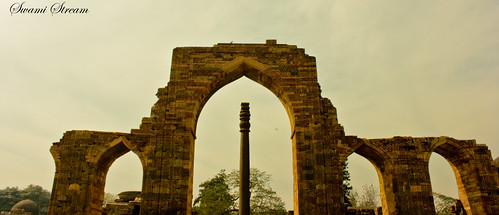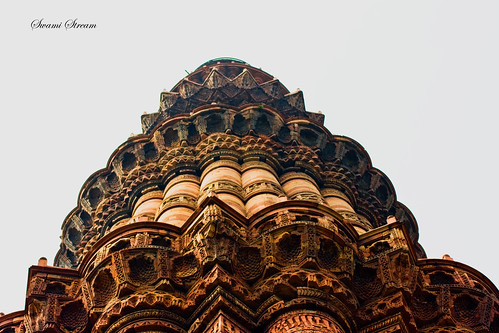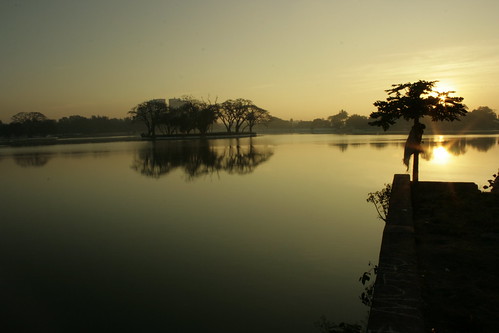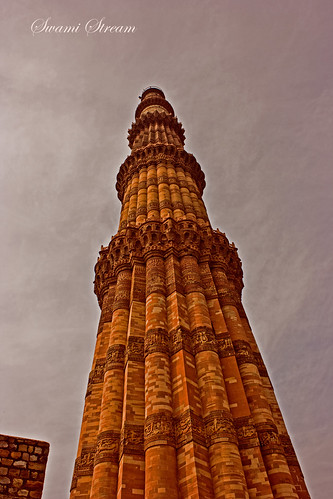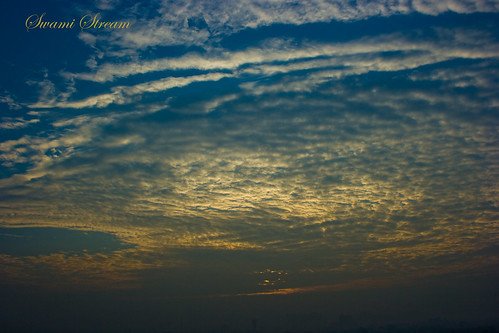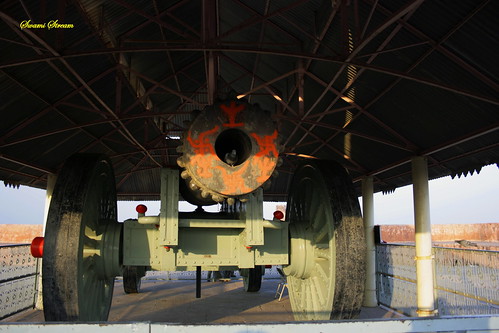The iron pillar of Delhi, India is a 7 meter (22 feet) high pillar next to the Qutub Minar. The pillar was apparently erected at the time of Chandragupta II and is a curiosity because of the composition of the metals used in its construction.
The pillar—almost seven meters (22 feet) high and weighing more than six tons—was allegedly erected at the time of Chandragupta II Vikramaditya (375–413), though other authorities give dates as early as 912 BCE. It is the only remaining piece of a Hindu and Jain temple complex which stood there before being destroyed by Qutb-ud-din Aybak who built around it when he constructed the Qutub Minar and Quwwat-ul-Islam mosque.
The pillar is 98% wrought iron of pure quality, and is a testament to the high level of skill achieved by ancient Indian ironsmiths. It has attracted the attention of both archaeologists and metallurgists, as it has withstood corrosion for 1600 years, despite harsh weather
The inscription reads (in the translation given in the tablets erected by Pandit Banke Rai in 1903):
He, on whose arm fame was inscribed by the sword, when, in battle in the Vanga countries (Bângal), he kneaded (and turned) back with (his) breast the enemies who, uniting together, came against (him);-he, by whom, having crossed in warfare the seven mouths of the (river) Sindhu, the Vâhlikas were conquered;-he, by the breezes of whose prowess the southern ocean is even still perfumed;- (Line 3.)-He, the remnant of the great zeal of whose energy, which utterly destroyed (his) enemies, like (the remnant of the great glowing heat) of a burned-out fire in a great forest, even now leaves not the earth; though he, the king, as if wearied, has quit this earth, and has gone to the other world, moving in (bodily) from to the land (of paradise) won by (the merit of his) actions, (but) remaining on (this) earth by (the memory of his) fame;- (L. 5.)-By him, the king,-who attained sole supreme sovereignty in the world, acquired by his own arm and (enjoyed) for a very long time; (and) who, having the name of Chandra, carried a beauty of countenance like (the beauty of) the full-moon,-having in faith fixed his mind upon (the god) Vishnu, this lofty standard of the divine Vishnu was set up on the hill (called) Vishnupada.
More at en.wikipedia.org/wiki/Iron_pillar_of_Delhi
Iron Pillar Panorama
Qutub Minar
This beautiful archaeological structure in India built in the year 1386 by Firuz Shah Tughluq may slowly become the learning Qutub Minar .It is 72 meters high (237.8 ft) with 379 steps leading to the top. The diameter of the base is 14.3 meters wide while the top floor measures 2.75 meters in diameter.
Research has found that this beautiful structure had already leaned 25 inches to the southwest , is in danger of leaning further in that direction due to a weak foundation being further weakened by rainwater seepage.
The 72.5 metre high Tughlaq-era structure is one of the three world heritage sites in Delhi, the other two being Humayun's Tomb and Red Fort. According to some historians, Qutub Minar has a 'natural' tilt which occurred not when it was built by Qutubuddin Aibak in 1173, but was caused either when the two upper storeys of the monument were later being built or due to an earthquake.
.
Previous Post
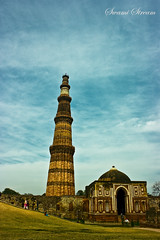
Qutub Minar 3
Qutub Minar
Qutub Minar (Urdu: قطب منار), a tower in Delhi, India, is the world's tallest brick minaret.[2] Construction commenced in 1193 under the orders of India's first Muslim ruler Qutb-ud-din Aibak, and the topmost storey of the minaret was completed in 1386 by Firuz Shah Tughluq. The Qutab Minar is notable for being one of the earliest and most prominent examples of Indo-Islamic architecture.
It is surrounded by several other ancient and medieval structures and ruins, collectively known as Qutub complex. The complex is listed as a UNESCO World Heritage Site and is one of the most popular tourist destinations in Delhi.
Inspired by the Minaret of Jam in Afghanistan and wishing to surpass it, Qutb-ud-din Aibak, the first Muslim ruler of Delhi, commenced construction of the Qutub Minar in 1193, but could only complete its base. His successor, Iltutmish, added three more storeys and, in 1368, Firuz Shah Tughluq constructed the fifth and the last storey. The Qutub Minar is itself built on the ruins of Lal Kot, the Red Citadel in the city of Dhillika, the capital of the Tomars and the Chauhans, the last Hindu rulers of Delhi.
Controversy also surrounds the origins for the name of the tower. Many historians believe that the Qutub Minar was named after the first Turkish sultan, Qutb-ud-din Aibak but others contend that it was named in honour of Qutbuddin Bakhtiar Kaki, a saint from Baghdad who came to live in India and was greatly venerated by Iltutmish.
More on en.wikipedia.org/wiki/Qutub_Minar
utab Minar going the way of the Leaning Tower of Pisa? Experts are understood to have expressed concern that the monument, which
Qutab Minar already has a tilt of 25 inches to the southwest, is in danger of leaning further in that direction due to a weak foundation being further weakened by rainwater seepage.
Reflections
One of the most beautiful shots of the Ulsoor lake that I have taken .
Qutub Minar
utub Minar (Urdu: قطب منار), a tower in Delhi, India, is the world's tallest brick minaret.[2] Construction commenced in 1193 under the orders of India's first Muslim ruler Qutb-ud-din Aibak, and the topmost storey of the minaret was completed in 1386 by Firuz Shah Tughluq. The Qutab Minar is notable for being one of the earliest and most prominent examples of Indo-Islamic architecture.
It is surrounded by several other ancient and medieval structures and ruins, collectively known as Qutub complex. The complex is listed as a UNESCO World Heritage Site and is one of the most popular tourist destinations in Delhi.
Inspired by the Minaret of Jam in Afghanistan and wishing to surpass it, Qutb-ud-din Aibak, the first Muslim ruler of Delhi, commenced construction of the Qutub Minar in 1193, but could only complete its base. His successor, Iltutmish, added three more storeys and, in 1368, Firuz Shah Tughluq constructed the fifth and the last storey. The development of architectural styles from Aibak to Tuglak are quite evident in the minaret. Like earlier towers erected by the Ghaznavids and Ghurids in Afghanistan, the Qutub Minar comprises several superposed flanged and cylindrical shafts, separated by balconies carried on Muqarnas corbels. The minaret is made of fluted red sandstone covered with intricate carvings and verses from the Qur'an. The Qutub Minar is itself built on the ruins of Lal Kot, the Red Citadel in the city of Dhillika, the capital of the Tomars and the Chauhans, the last Hindu rulers of Delhi.
The purpose for building this monument has been variously speculated upon. It could take the usual role of a minaret, calling people for prayer in the Quwwat-ul-Islam mosque, the earliest extant mosque built by the Delhi Sultans. Other possibilities are a tower of victory, a monument signifying the might of Islam, or a watch tower for defense. Controversy also surrounds the origins for the name of the tower. Many historians believe that the Qutub Minar was named after the first Turkish sultan, Qutb-ud-din Aibak but others contend that it was named in honour of Qutbuddin Bakhtiar Kaki, a saint from Baghdad who came to live in India and was greatly venerated by Iltutmish.
The nearby Iron Pillar is one of the world's foremost metallurgical curiosities, standing in the famous Qutub Complex. According to the traditional belief, any one who can encircle the entire column with their arms, with their back towards the pillar, can have their wish granted. Because of the corrosive qualities of sweat.
More on en.wikipedia.org/wiki/Qutub_Minar
Gurgaon Sunrise
I shot this beautiful Sunrise from my Balcony in Gurgoan. The winter here can create dramatic skies
The Largest Canon (Jaivan)
This is the is shot of the Largest Canon of its time called Jaivan. I shot this at Jaigarh fort in Jaipur. The canon ball is 50 Kgs and had a range of 30 KM and requires 100 Kgs of Gun powder. This was only fired once and never used any any battle. Its a sight to see
